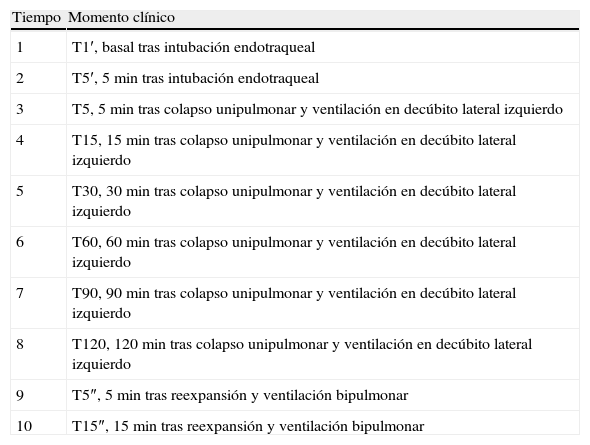Comparar las presiones en la vía aérea obtenidas antes del tubo endotraqueal con las intratraqueales en la modalidad ventilatoria de flujo continuo, en cirugía toracoscópica para ventilación unipulmonar, en modelo pediátrico en animales.
Material y métodosEstudio prospectivo observacional simple. Se emplearon 10 cerdos Large White, con un peso de 4,6±0,8kg. Los animales se ventilaron en modo neonatal (flujo continuo) con un respirador Temel Supra. Mediante traqueotomía realizamos un sellado completo del sistema respiratorio para usar tubos sin neumotaponamiento especiales que permiten el registro traqueal de presiones sin interferir en la ventilación. Se realizó colapso del pulmón derecho por videotoracoscopia y se mantuvo durante 120min. Las variables se analizaron en 10 tiempos: inicio y 5min en bipulmonar, tras el colapso en los tiempos 5, 15, 30, 60, 90 y 120min, y 5 y 15min tras la reexpansión pulmonar. Registramos la presión basal, pico, meseta y teleespiratoria en la boca del animal e intratraqueal.
ResultadosLa media de la presión pico en la boca del animal en ventilación unipulmonar fue de 23,38mmHg y traqueal de 21,24mmHg, mientras que la media de la presión meseta en la boca de animal en ventilación unipulmonar fue de 21,88mmHg y traqueal de 21,39mmHg, respectivamente, con diferencias significativas en todas (p<0,05). Encontramos diferencias estadísticamente significativas (p<0,05) para la presión pico y meseta al comparar el registro en la boca del animal con el registro traqueal, siendo la diferencia en valor absoluto mayor para el registro de presión pico.
ConclusionesLos parámetros de presiones registrados en la boca del animal fueron asumibles para la cirugía, manteniéndose una adecuada estabilidad respiratoria y hemodinámica. Podemos afirmar que la modalidad de flujo continuo según el estudio de presiones puede ser idónea para este tipo de cirugía, y que el registro en la boca del animal (paciente) para la presión pico no refleja lo que realmente ocurre en el alvéolo, pero sí podemos tener una aproximación clínica adecuada para la presión meseta.
To compare the airway pressures obtained before the endotracheal tube with the intratracheal ones in the continuous flow ventilation mode, in thoracoscopic surgery for one lung ventilation, in a paediatric model in animals.
Material and methodsA simple prospective observational study was conducted. Ten Large White pigs weighing 4.6±0.8kg were used. The animals were ventilated in neonatal mode (continuous flow) with a Temel Supra ventilator. Using tracheotomy, we completely sealed the respiratory system in order to use tubes without special endotracheal cuffs, which would enable tracheal pressures to be registered without interfering with ventilation. Collapse of the right lung was performed by videothoracoscopy and was maintained for 120min. The variables were measured at 10 time periods: start and 5min with both lungs, after collapse at 5, 15, 30, 60, 90 and 120min, and 5 and 15min after lung re-expansion. We recorded the baseline, peak, plateau and positive end expiratory pressure in the mouth of the animal and intratracheal.
ResultsThe mean peak pressure in the mouth of the animal in one lung ventilation was 23.38mmHg and tracheal ventilation was 21.24mmHg, while the mean plateau pressure in the mouth of the animal in one lung ventilation it was 21.88mmHg and tracheal was 21.39mmHg, respectively, with significant differences in all of them (P<.05). We found statistically significant differences (P<.05) for peak and plateau pressure on comparing the record in the animal mouth with the tracheal record. The difference in absolute value was higher for the peak pressure record.
ConclusionsThe pressure parameters recorded in the animal mouth were acceptable for surgery, with a suitable respiratory and haemodynamic stability being maintained. We can state that the continuous flow mode according to the pressures study may be suitable for this type of surgery, and that the mouth of the animal (patient) record for the peak pressure does not reflect what really happens in the alveoli, but we can give a suitable clinical estimate for the plateau pressure.
Artículo
Comprando el artículo el PDF del mismo podrá ser descargado
Precio 19,34 €
Comprar ahora














